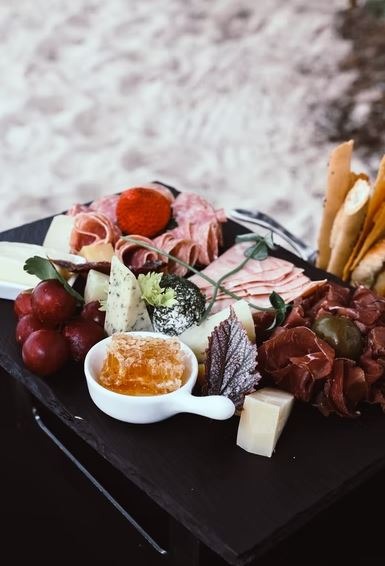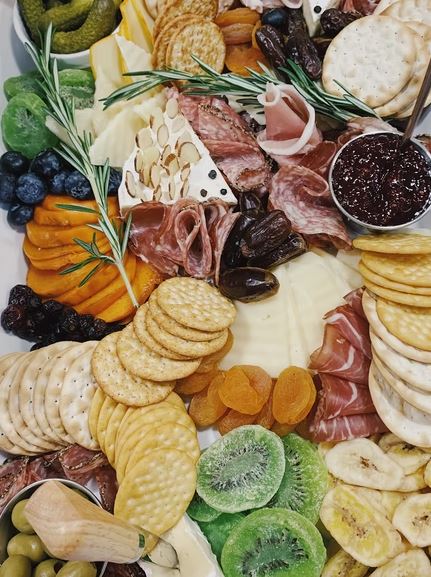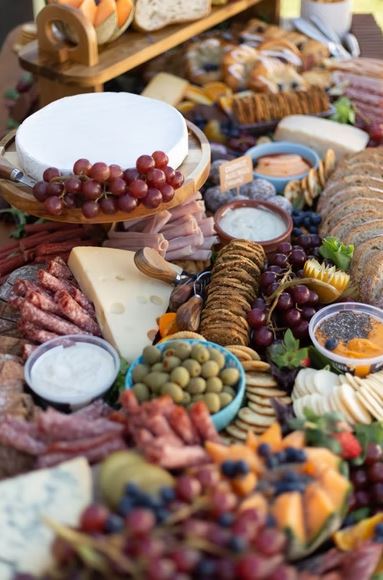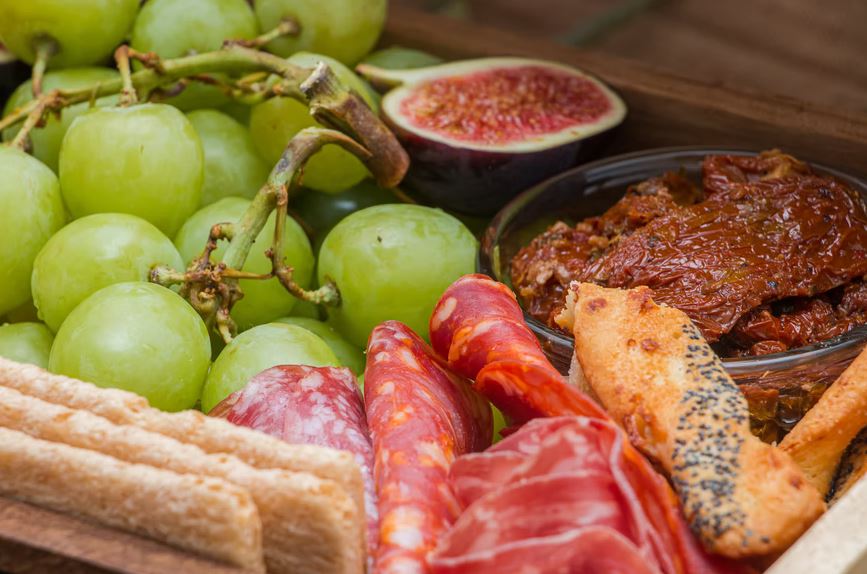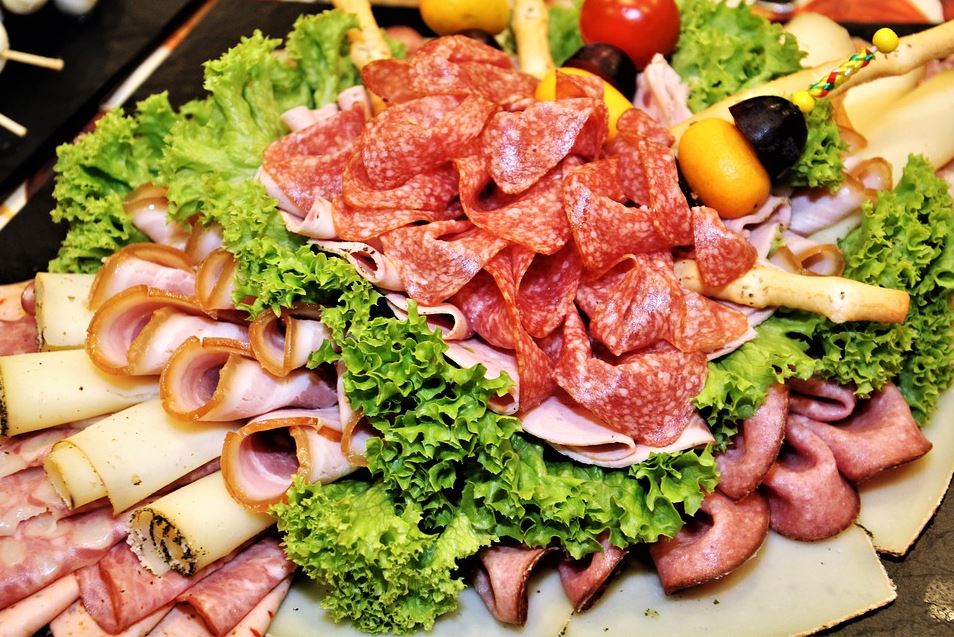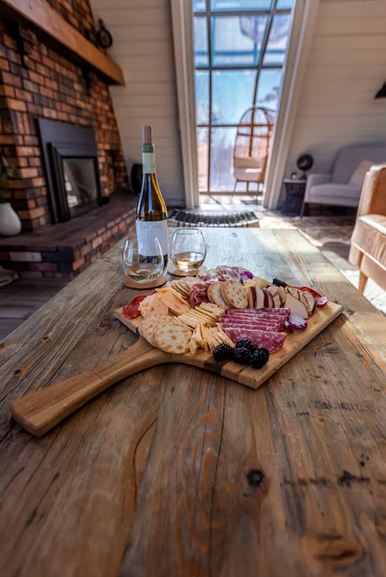A great charcuterie board is life to the party. It’s fun and pretty to look at, easy to assemble, and once you have put together a great selection, you’re set on appetizers. Plus, you don’t need to spend much to make a classy-looking appetizer. Another bonus is that it will surely rack up likes on your Instagram!
Here are some tips for putting together the best charcuterie board for your next party:
1. Give your guests a solid selection.
When putting up a charcuterie board, think well beyond just meat, cheese, and grapes. Most guests seem to enjoy charcuterie boards with multiple, easy-to-grab items that they can pick over multiple glasses of wine. This way, you don’t have to worry about what your guests may like or not.
You’ll want to have three to five different types of meat and at least two types of cheese. Include fruits, nuts, dips, spreads, jams, pickled foods, and much more.
2. Factor the amount of meat per person.
Like how you might factor a wine per person at a party, considering the amount of meat to serve per person is a great way to avoid overspending and underbuying. Cured meats can be expensive, and there’s no need to go overboard when you buy them. Aim for about two ounces of meat per person. Not everyone will eat two ounces of meat, but someone is sure to eat more, and someone is sure to eat less.
3. Vary textures and flavors on the board.
Variety is pleasing to the eye and to the palate. This is especially true when it comes to charcuterie boards. For example, instead of serving three different kinds of hard salamis, use just one like chorizo or soppressata, then pair it with thinly-sliced meats like prosciutto or Jamon. Then, incorporate softer, paste-like meats like a pate or rillettes. This way, your guests can also enjoy different flavor profiles of charcuterie.
The same way goes for cheeses that you want to serve. Make sure you get something hard with something creamy or something mild with something sharp.
Then, don’t forget the carbs. A sliced baguette is an excellent choice for serving salty meats and cheeses, as well as plain crackers and crostini.
4. Mix savory with sweets and acidic foods.
After all that meats, cheese, and crackers, you’re going to need something sweet to balance those rich, savory flavors. Accent the board with acidic pickles, whole grain mustard, crunchy nuts, sweet jam or honey, and tinned fish. Dried fruit of any sort works well, so does a bar of good chocolate, especially if you’re serving wine.
5. Add some warmth.
If you’re hosting a party in the winter holidays, you can add something warm to the board. Cold cuts may feel unwelcoming during the snowy season, and if you add something like warm rillettes or crisped-up sausage, you can please all the senses.
6. Add something fresh.
It’s always best to pair the decadence of charcuterie with something refreshing like apples or pears, depending on the season. Grapes, pomegranate seeds, and figs also work well here.
7. Slice meats as thinly as possible.
Meats are often rich and salty, so when you’re shopping, you can ask the sales clerk to slice the meat as thinly as possible. If you’re serving a whole dried sausage, cut at least a third of it before you put it on the board, then place a paring knife nearby for guests to finish the job.
8. Cut the cheese and change up the look of the meat.
Charcuterie is easier to grab when rolled up than when it’s staggered as it comes in the package or when sliced at the deli. As you serve your meats, remember that presentation is key. Change up the look of the meats. For example, you can fold big slices of salami into quarters, gently roll up individual slices of prosciutto, and fan out smaller slices of sliced-up charcuterie.
If you have larger rounds or wedges of cheese, cut them up in half or quarters, then spread it around the cheeseboard. This way, if two guests want to get some brie, one doesn’t have to wait while the other cuts up their slice as there would be two or more in the platter.
9. Consider the composition.
To start arranging the charcuterie board, arrange your small bowls off-center, then place the meat and its accompaniments around them. Think about the overall look as you work. Place the non-meat elements like crackers, bread, fruits, and nuts between the different charcuteries. This will help create a distinction between the meats you serve. Place the cheese strategically as well. Make sure that the colors are well-balanced around the board – the red meats should not be gathered on one side only, and the yellow cheeses and colorful fruits and dips on the other.
10. Fill up bare spots.
A tightly-packed charcuterie board is usually more appealing than those with wide-open spaces between different charcuterie elements. Plus, when you’re serving for a party, you can’t afford to have a widely-spaced board with less food, which can be finished up quickly. It’s best to fill bare spots with goodness that people can eat.
In case of awkward bare spots where you can’t pick what food to scatter, a bag of arugula or other small loose-leaf lettuce could come in handy. Use the leaves to fill in spaces and tuck them under items that won’t be affected by their presence. Plus, it adds a nice pop of green color to your charcuterie board. But if you choose to go this way, make sure that the greens are distributed as evenly as possible around the board.
Alternatively, you can use sprigs of rosemary or thyme to fill up the spots and garnish your board.
11. Use small dishes.
To contain some items like olives, dips, and condiments that might bleed into another ingredient, use small dishes like ramekins or small dipping bowls. It can also give your platter an eye-catching dimension.
12. Add some finishing touches.
Just before serving the charcuterie board, drizzle the meats with a little bit of olive oil. Sprinkle the pate, mousse, or rillettes with flaky sea salt and ground black pepper.
13. Prepare it in advance.
Since you’re probably going to handle a lot of things for the party, don’t be afraid to assemble the charcuterie board hours before your party. Just cover it with plastic wrap and refrigerate until you’re ready to serve. Don’t assemble it overnight or more than a few hours before, though – the meat might dry out. Add fruits that might brown, like pears and apples, just before serving.
14. Don’t forget the wine.
Nothing pairs better than a good charcuterie board than wine. While there are so many flavors happening on the board, anything goes when it comes to wine. Offer several unique bottles of red , white, rose, and sparkling wine on hand.

